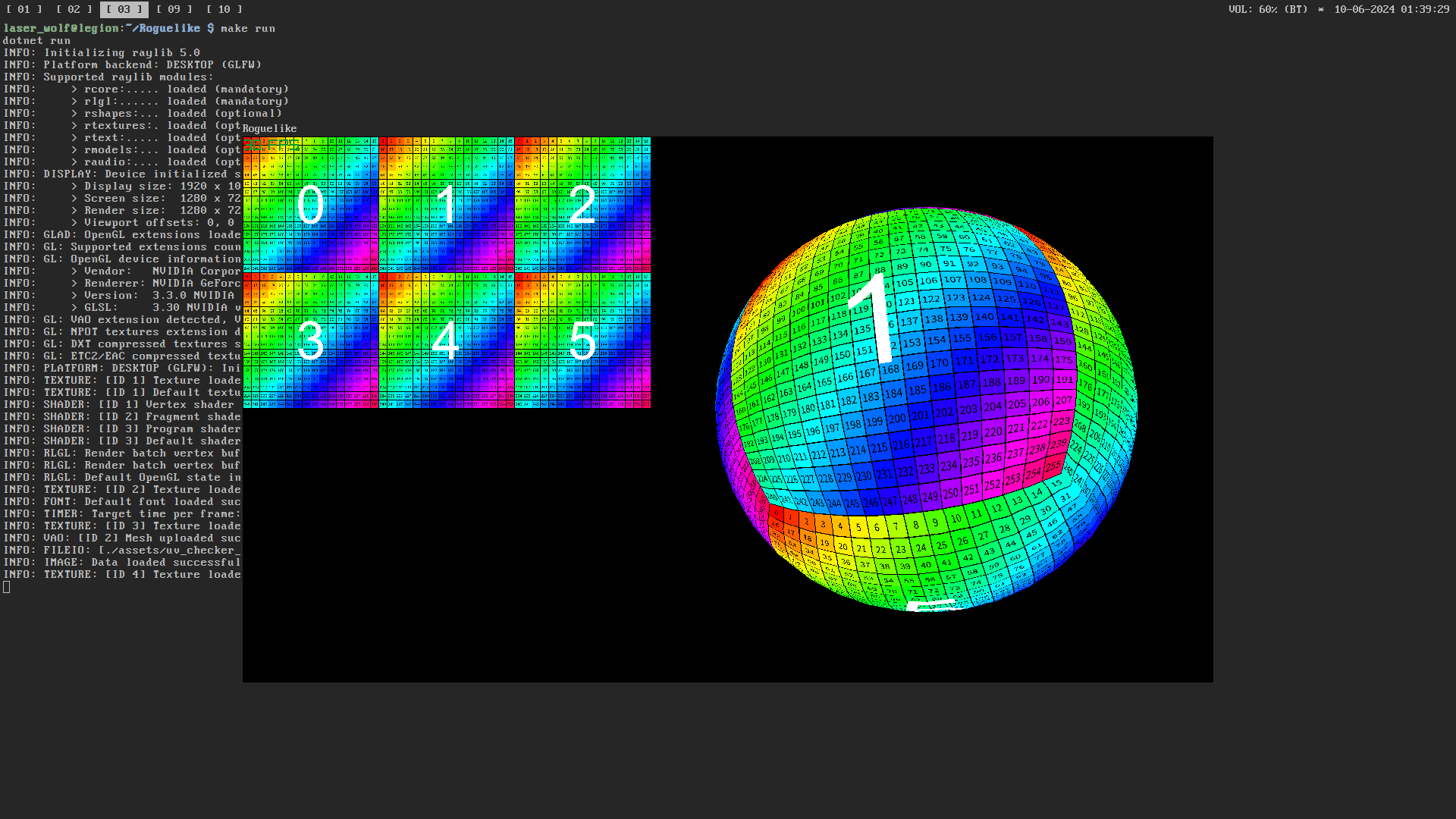C# roguelike, devlog 8: Mesh generation and cube to sphere projection
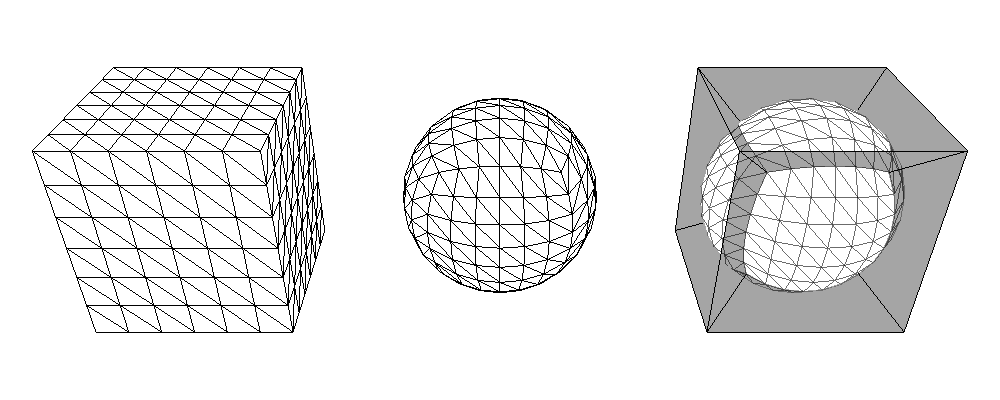
Introduction
Moving forward I would like to try to procedurally generate planets.
I am going for the approach of generating a cube and projecting the cube as a sphere.
Here I’ve looked at the writings Wraparound square tile maps on a sphere by Amit Patel and Cube Sphere: Going from Cube to Sphere by Jasper Flick.
Procedure
For planet generation I’ll make the six cube faces out of grids of 1x1 squares. Then fold the faces into a cube and turn the cube into a sphere.
The vertices on a cube face should be shared between the neighboring squares in the grid, so there needs to be some rules that dictate which squares should create new vertices and on which corners, and a way for squares to find the index value of previously created vertices and use those when creating the triangles for the current square.
The rules for which squares create which vertices are as follows:
- All squares need to create a new vertex in the lower-right corner.
- All the leftmost squares need to create a new vertex in the lower-left corner.
- All the topmost squares need to create a new vertex in the top-right corner.
The rules for finding the vertex index values of squares to the left or above the current square are as follows:
vertTopLeft = currentVertIndex - (size + (x == 0 ? 1 : 2));
vertTopRight = vertTopLeft + 1;
vertBottomLeft = currentVertIndex - 1;
if (y == 0)
{
vertTopLeft = currentVertIndex - (x == 1 ? 3 : 2);
}
if (y == 1)
{
vertTopLeft += (x == 0 ? x + 1 : x) - size;
vertTopRight = vertTopLeft + (x == 0 ? 1 : 2);
}
So it’s actually super simple and the process of creating a planet would be like this:
Let’s say the planet has the size 3, which means creating 6 cube faces of 3x3 grids of 1x1 squares. That means that the triangles in each cube face will require (3 + 1) * (3 + 1) vertices and (3 * 3) * 2 triangles (two triangles for each square). So each face will have 16 vertices and 18 triangles, totalling 108 triangles and 96 squares. The vertex index value will start at zero and go to 95, and all the squares will use the rules above to find the correct vertex index for it’s corners.
Here’s an illustration of the process with an asterisk placed next to vertices in the square that they are created in:
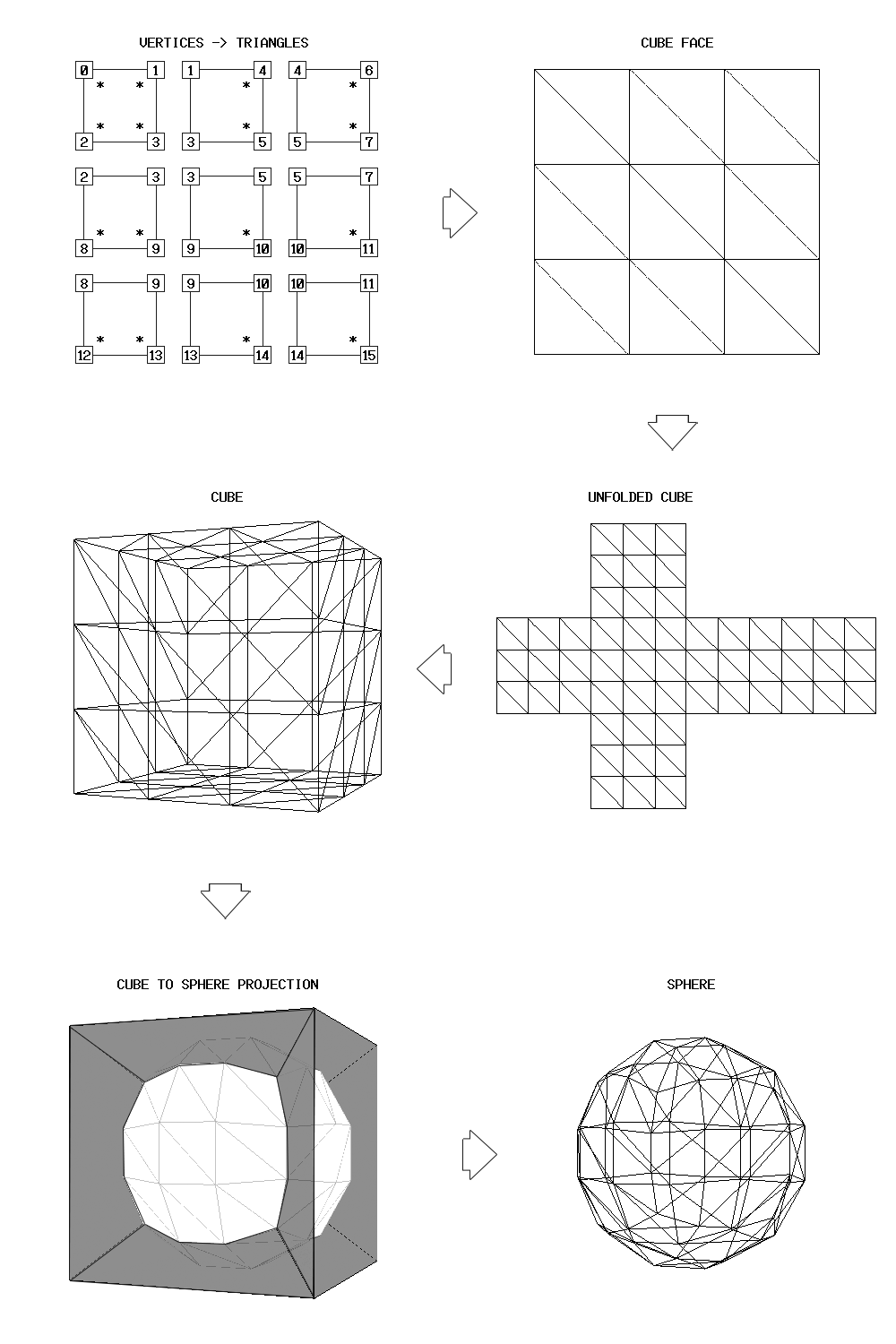
For the formula used to transform the cube to a sphere I’ve used the one from Jasper Flick’s Cube Sphere tutorial:

I’m not sure if this the best way to adapt the formula in C#, but to get it to work properly I had to divide the Vector3 point by (size * 0.5f) before applying the formula and then multiplying the Vector3 point by (size * 0.5f) after applying the formula:
private Vector3 TransformCubeToSphere(Vector3 p)
{
p /= size * 0.5f;
float x = p.X * (float)Math.Sqrt(1f - (((p.Y * p.Y) + (p.Z * p.Z)) / (2f)) + (((p.Y * p.Y) * (p.Z * p.Z)) / (3f)));
float y = p.Y * (float)Math.Sqrt(1f - (((p.X * p.X) + (p.Z * p.Z)) / (2f)) + (((p.X * p.X) * (p.Z * p.Z)) / (3f)));
float z = p.Z * (float)Math.Sqrt(1f - (((p.X * p.X) + (p.Y * p.Y)) / (2f)) + (((p.X * p.X) * (p.Y * p.Y)) / (3f)));
return new Vector3(x, y, z) * (size * 0.5f);
}
Then there’s the calculation of normals for the vertices. Since the planet is just a flat sphere at this point it’s super easy, and the normals are just a normalized version of the Vector3 point: normals[vertIndex] = Vector3.Normalize(vertices[vertIndex]).
But the vertices will also need UV coordinates for texturing the mesh.
Here is an indexed illustration of the unfolded cube:
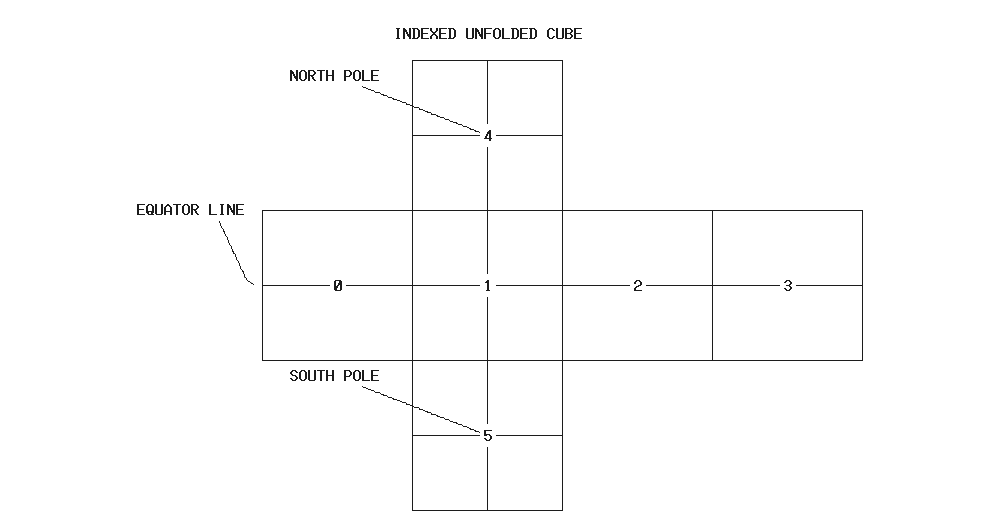
And here’s an indexed illustration of the layout I’ll use for the planet texture:
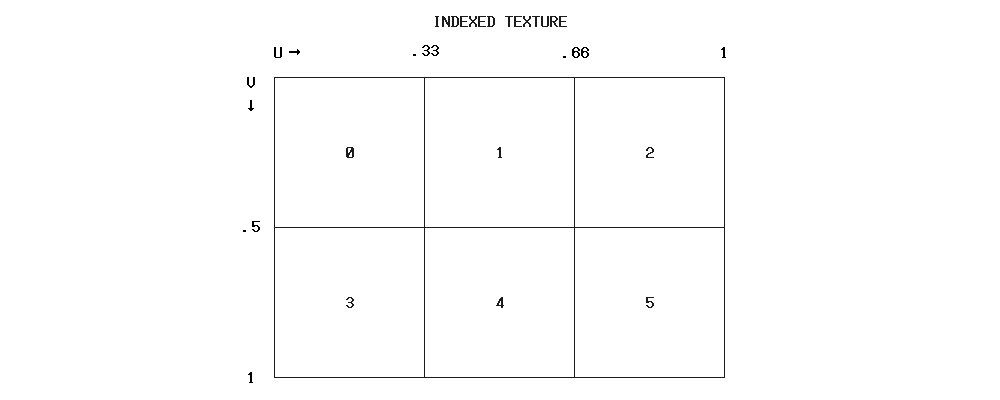
Note: The V axis usually goes from bottom-to-top during UV mapping, but when using Raylib it seems to go from top-to-bottom by default, which in my opinion is preferable and much easier to work with.
I’ll use the following rules when setting the UV coordinates for each vertex:
float texCoordUStart = 0f;
float texCoordVStart = 0f;
float texCoordUSize = 1f / 3f;
float texCoordVSize = 1f / 2f;
switch (face)
{
case 0:
texCoordUStart = 0f;
texCoordVStart = 0f;
break;
case 1:
texCoordUStart = texCoordUSize;
texCoordVStart = 0f;
break;
case 2:
texCoordUStart = texCoordUSize * 2;
texCoordVStart = 0f;
break;
case 3:
texCoordUStart = 0f;
texCoordVStart = texCoordVSize;
break;
case 4:
texCoordUStart = texCoordUSize;
texCoordVStart = texCoordVSize;
break;
case 5:
texCoordUStart = texCoordUSize * 2;
texCoordVStart = texCoordVSize;
break;
}
float texCoordLeft = texCoordUStart + ((float)x * (texCoordUSize / (float)size));
float texCoordRight = texCoordUStart + (((float)x + 1f) * (texCoordUSize / (float)size));
float texCoordTop = texCoordVStart + ((float)y * (texCoordVSize / (float)size));
float texCoordBottom = texCoordVStart + (((float)y + 1f) * (texCoordVSize / (float)size));
Here is an example of a texture applied to the generated sphere:
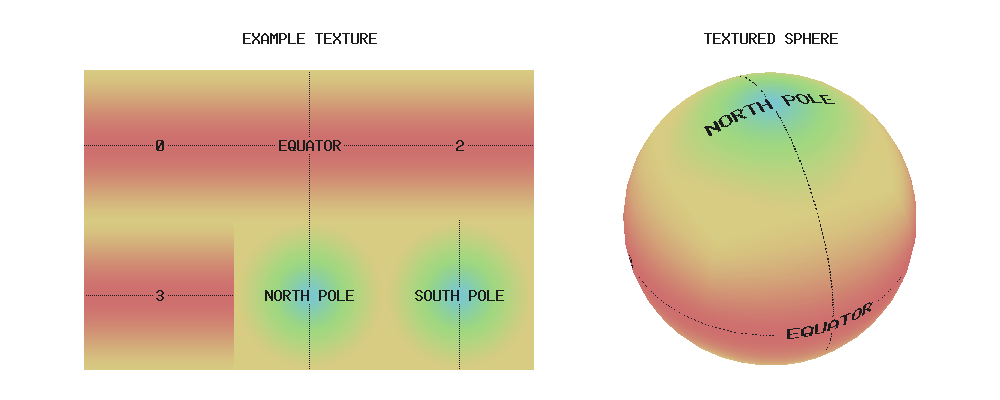
Implementation
├── assets
│ └── + uv_checker_cubemap_1024.png
├── Makefile
├── Roguelike.csproj
└── src
├── BspNode.cs
├── BspTree.cs
├── Corridor.cs
├── Game.cs
├── LogEntry.cs
├── Logger.cs
├── Map.cs
├── PathGraph.cs
├── + Planet.cs
├── Rand.cs
├── Room.cs
└── Vec2.cs
The uv_checker_cubemap_1024.png texture for testing of UV mapping can be downloaded here.
I made the texture from an image found here.
Note: In this part of the project I’ll disable the map and player while I’m focusing on the planet generation.
...
public static Map map { get; private set; }
public static Player player { get; private set; }
+ public static Planet planet { get; private set; }
...
// Initialize
private static void Init()
{
// Raylib & Imgui initialization
Raylib.InitWindow(1280, 720, "Roguelike");
Raylib.SetTargetFPS(30);
rlImGui.Setup(true);
// Create new objects
- map = new Map(96, 48);
- player = new Player();
+ //map = new Map(96, 48);
+ //player = new Player();
+ planet = new Planet(10);
// Camera setup
camera.Position = Vector3.Zero;
camera.Target = Vector3.Zero;
camera.Up = Vector3.UnitY;
camera.FovY = 45.0f;
camera.Projection = CameraProjection.Perspective;
}
...
// Exit game
private static void Exit()
{
+ planet.Exit();
rlImGui.Shutdown();
Raylib.CloseWindow();
}
// Handle user input
private static void Input()
{
// System
if (Raylib.IsKeyPressed(KeyboardKey.Tab)) { debugMode = !debugMode; }
if (Raylib.IsKeyPressed(KeyboardKey.F)) { Raylib.ToggleFullscreen(); }
- if (Raylib.IsKeyPressed(KeyboardKey.Up)) { player.MoveUp(); }
- else if (Raylib.IsKeyPressed(KeyboardKey.Down)) { player.MoveDown(); }
- else if (Raylib.IsKeyPressed(KeyboardKey.Left)) { player.MoveLeft(); }
- else if (Raylib.IsKeyPressed(KeyboardKey.Right)) { player.MoveRight(); }
+ //if (Raylib.IsKeyPressed(KeyboardKey.Up)) { player.MoveUp(); }
+ //else if (Raylib.IsKeyPressed(KeyboardKey.Down)) { player.MoveDown(); }
+ //else if (Raylib.IsKeyPressed(KeyboardKey.Left)) { player.MoveLeft(); }
+ //else if (Raylib.IsKeyPressed(KeyboardKey.Right)) { player.MoveRight(); }
}
...
// Update things in the game
private static void Update()
{
float deltaTime = Raylib.GetFrameTime();
+ planet.Update(deltaTime);
// Camera
- Vector3 cameraTargetGoal = new Vector3((float)player.x, 0f, (float)player.y);
+ //Vector3 cameraTargetGoal = new Vector3((float)player.x, 0f, (float)player.y);
Vector3 cameraTargetGoal = planet.pos;
camera.Target = Raymath.Vector3Distance(camera.Target, cameraTargetGoal) > 0.1f ? Raymath.Vector3Lerp(camera.Target, cameraTargetGoal, 0.05f) : camera.Target;
- camera.Position = camera.Target + new Vector3(0f, 16.0f, 12.0f);
+ camera.Position = camera.Target + new Vector3(0f, 18.0f, 18.0f);
}
// Render things on screen
private static void Render()
{
// Start render
Raylib.BeginDrawing();
// Set background color
Raylib.ClearBackground(Color.Black);
// 3D rendering
Raylib.BeginMode3D(camera);
if (debugMode) { Raylib.DrawGrid(300, 1.0f); }
- map.Render3D();
- player.Render3D();
+ //map.Render3D();
+ //player.Render3D();
+ planet.Render3D();
Raylib.EndMode3D();
// 2D rendering
- map.Render2D();
+ //map.Render2D();
+ planet.Render2D();
Raylib.DrawFPS(2,2);
- Raylib.DrawText("POSITION: " + player.x.ToString() + "x" + player.y.ToString(), 2, Raylib.GetRenderHeight() - 16, 16, Color.White);
+ //Raylib.DrawText("POSITION: " + player.x.ToString() + "x" + player.y.ToString(), 2, Raylib.GetRenderHeight() - 16, 16, Color.White);
// 2D rendering (debug mode)
if (debugMode) {
Raylib.DrawText("DEBUG MODE", 2, 20, 16, Color.White);
RenderImGui();
}
// End render
Raylib.EndDrawing();
}
...
using Raylib_cs;
using System.Numerics;
namespace Roguelike;
/// <summary>
/// A round astronomical body.
/// </summary>
public class Planet
{
public readonly int size;
public Vector3 pos { get; private set; }
private Vector3 rotation = Vector3.Zero;
private Model model;
private Texture2D texture;
// Constructor
public Planet(int size)
{
this.size = size;
this.pos = Vector3.Zero;
Generate();
}
// Generate the planet
private unsafe void Generate()
{
// Generate mesh
model = Raylib.LoadModelFromMesh(MakeMesh(flat: false));
// Set model texture
texture = Raylib.LoadTexture("./assets/uv_checker_cubemap_1024.png");
Raylib.SetMaterialTexture(ref model, 0, MaterialMapIndex.Albedo, ref texture);
}
// Called every frame
public void Update(float deltaTime)
{
Rotate(new Vector3(0.1f, 0f, 0.1f) * deltaTime);
}
// Render 3D graphics
public void Render3D()
{
Vector3 renderOffset = new Vector3(size * 0.7f, 0f, 0f);
Raylib.DrawModel(model, pos + renderOffset, 1.0f, Color.White);
}
// Render 2D graphics
public void Render2D()
{
float texDisplaySize = 0.175f;
Raylib.DrawTextureEx(texture, new Vector2(0f, 0f), 0f, texDisplaySize, Color.White);
}
// Free allocated memory
public void Exit()
{
Raylib.UnloadTexture(texture);
Raylib.UnloadModel(model);
}
// Rotate the planet model
public unsafe void Rotate(Vector3 newRotation)
{
rotation += newRotation;
model.Transform = Raymath.MatrixRotateXYZ(rotation);
}
// Transform a given cube face index & grid position to a 3D point in local space
private unsafe Vector3 Transform2Dto3D(int face, Vector2 pos, bool flat = false)
{
// Flat mode
if (flat) { return Transform2DToFlat(face, pos); }
// Sphere mode
return TransformCubeToSphere(Transform2DToCube(face, pos));
}
// Project the planet as a 3D unfolded cube
private Vector3 Transform2DToFlat(int face, Vector2 pos)
{
Vector3 result = new Vector3(pos.X - (float)size * 2, 0f, pos.Y - (float)size);
switch (face)
{
case 1: result += new Vector3((float)size, 0.0f, 0.0f); break;
case 2: result += new Vector3((float)size * 2, 0.0f, 0.0f); break;
case 3: result += new Vector3((float)size * 3, 0.0f, 0.0f); break;
case 4: result += new Vector3((float)size, 0.0f, -(float)size); break;
case 5: result += new Vector3((float)size, 0.0f, (float)size); break;
}
return result;
}
// Project the planet as a 3D cube
private Vector3 Transform2DToCube(int face, Vector2 pos)
{
Vector3 result = Vector3.Zero;
Vector3 offset = new Vector3(-(float)size / 2, (float)size / 2, -(float)size / 2);
switch (face)
{
case 0: result = offset + new Vector3(0f, pos.X - (float)size, pos.Y); break;
case 1: result = offset + new Vector3(pos.X, 0f, pos.Y); break;
case 2: result = offset + new Vector3((float)size, ((float)size - pos.X) - (float)size, pos.Y); break;
case 3: result = offset + new Vector3((float)size - pos.X, -(float)size, pos.Y); break;
case 4: result = offset + new Vector3(pos.X, (pos.Y - (float)size), 0f); break;
case 5: result = offset + new Vector3(pos.X, ((float)size - pos.Y) - (float)size, (float)size); break;
}
return result;
}
// Cube to sphere projection
private Vector3 TransformCubeToSphere(Vector3 p)
{
p /= size * 0.5f;
float x = p.X * (float)Math.Sqrt(1f - (((p.Y * p.Y) + (p.Z * p.Z)) / (2f)) + (((p.Y * p.Y) * (p.Z * p.Z)) / (3f)));
float y = p.Y * (float)Math.Sqrt(1f - (((p.X * p.X) + (p.Z * p.Z)) / (2f)) + (((p.X * p.X) * (p.Z * p.Z)) / (3f)));
float z = p.Z * (float)Math.Sqrt(1f - (((p.X * p.X) + (p.Y * p.Y)) / (2f)) + (((p.X * p.X) * (p.Y * p.Y)) / (3f)));
return new Vector3(x, y, z) * (size * 0.5f);
}
// Generate the 3D mesh for the planet
private unsafe Mesh MakeMesh(bool flat = true)
{
// Set mesh specs
int faceNumVerts = (size + 1) * (size + 1);
int numVerts = 6 * faceNumVerts;
int numTris = 2 * (6 * (size * size));
// Allocate memory for the mesh
Mesh mesh = new(numVerts, numTris);
mesh.AllocVertices();
mesh.AllocTexCoords();
mesh.AllocNormals();
mesh.AllocIndices();
// Contigous regions of memory set aside for mesh data
Span<Vector3> vertices = mesh.VerticesAs<Vector3>();
Span<Vector2> texcoords = mesh.TexCoordsAs<Vector2>();
Span<ushort> indices = mesh.IndicesAs<ushort>();
Span<Vector3> normals = mesh.NormalsAs<Vector3>();
// Make lookup table for cube face vert index start position
int[] faceVertIndex = new int[6];
for (int face = 0; face < 6; face++){
faceVertIndex[face] = faceNumVerts * face;
}
// Loop through all cube faces
ushort vertIndex = 0;
int triIndex = 0;
Color color = Color.White;
for (int face = 0; face < 6; face++)
{
for (int y = 0; y < size; y++)
{
for (int x = 0; x < size; x++)
{
// Set UV cordinates for vertices on the current grid position
float texCoordUStart = 0f;
float texCoordVStart = 0f;
float texCoordUSize = 1f / 3f;
float texCoordVSize = 1f / 2f;
switch (face)
{
case 0:
texCoordUStart = 0f;
texCoordVStart = 0f;
break;
case 1:
texCoordUStart = texCoordUSize;
texCoordVStart = 0f;
break;
case 2:
texCoordUStart = texCoordUSize * 2;
texCoordVStart = 0f;
break;
case 3:
texCoordUStart = 0f;
texCoordVStart = texCoordVSize;
break;
case 4:
texCoordUStart = texCoordUSize;
texCoordVStart = texCoordVSize;
break;
case 5:
texCoordUStart = texCoordUSize * 2;
texCoordVStart = texCoordVSize;
break;
}
float texCoordLeft = texCoordUStart + ((float)x * (texCoordUSize / (float)size));
float texCoordRight = texCoordUStart + (((float)x + 1f) * (texCoordUSize / (float)size));
float texCoordTop = texCoordVStart + ((float)y * (texCoordVSize / (float)size));
float texCoordBottom = texCoordVStart + (((float)y + 1f) * (texCoordVSize / (float)size));
// Set vertex indexes
int vertIndexStart = vertIndex;
ushort vertTopLeft = (ushort)(vertIndex - (size + (x == 0 ? 1 : 2)));
ushort vertTopRight = (ushort)(vertTopLeft + 1);
ushort vertBottomLeft = (ushort)(vertIndex - 1);
if (y == 0)
{
vertTopLeft = (ushort)(vertIndex - (x == 1 ? 3 : 2));
}
if (y == 1)
{
vertTopLeft += (ushort)((x == 0 ? x + 1 : x) - size);
vertTopRight = (ushort)(vertTopLeft + (x == 0 ? 1 : 2));
}
// Make top-left vertex
if (y == 0 && x == 0)
{
vertices[vertIndex] = Transform2Dto3D(face, new Vector2(x, y), flat: flat);
normals[vertIndex] = Vector3.Normalize(vertices[vertIndex]);
texcoords[vertIndex] = new(texCoordLeft, texCoordTop);
vertTopLeft = (ushort)(vertIndex);
vertIndex++;
}
// Make top-right vertex
if (y == 0)
{
vertices[vertIndex] = Transform2Dto3D(face, new Vector2(x + 1, y), flat: flat);
normals[vertIndex] = Vector3.Normalize(vertices[vertIndex]);
texcoords[vertIndex] = new(texCoordRight, texCoordTop);
vertTopRight = (ushort)(vertIndex);
vertIndex++;
}
// Make bottom-left vertex
if (x == 0)
{
vertices[vertIndex] = Transform2Dto3D(face, new Vector2(x, y + 1), flat: flat);
normals[vertIndex] = Vector3.Normalize(vertices[vertIndex]);
texcoords[vertIndex] = new(texCoordLeft, texCoordBottom);
vertBottomLeft = (ushort)(vertIndex);
vertIndex++;
}
// Make bottom-right vertex
vertices[vertIndex] = Transform2Dto3D(face, new Vector2(x + 1, y + 1), flat: flat);
normals[vertIndex] = Vector3.Normalize(vertices[vertIndex]);
texcoords[vertIndex] = new(texCoordRight, texCoordBottom);
ushort vertBottomRight = (ushort)(vertIndex);
vertIndex++;
// Triangle 1 (Counter-clockwise winding order)
indices[triIndex] = vertTopLeft;
indices[triIndex + 1] = vertBottomRight;
indices[triIndex + 2] = vertTopRight;
triIndex += 3;
// Triangle 2 (Counter-clockwise winding order)
indices[triIndex] = vertTopLeft;
indices[triIndex + 1] = vertBottomLeft;
indices[triIndex + 2] = vertBottomRight;
triIndex += 3;
}
}
}
// Upload mesh data from CPU (RAM) to GPU (VRAM)
Raylib.UploadMesh(ref mesh, false);
// Return the finished mesh
return mesh;
}
}
Extra
This is not really used in the planet generation, but here’s the code for the mesh i used to visualize the cube to sphere projection used in the image on top of this page.
This was inspired by Fig. 2.1 in Dimitrijević, A., Lambers, M., & Rančić, D. (2016): Comparison of spherical cube map projections used in planet-sized terrain rendering.
// Generate the 3D mesh for visualization of cube to sphere projection
private unsafe Mesh MakeMeshProjection()
{
int numVerts = 9;
int numTris = 24;
// Allocate memory for the mesh
Mesh mesh = new(numVerts, numTris);
mesh.AllocVertices();
mesh.AllocColors();
mesh.AllocIndices();
// Contigous regions of memory set aside for mesh data
Span<Vector3> vertices = mesh.VerticesAs<Vector3>();
Span<Color> colors = mesh.ColorsAs<Color>();
Span<ushort> indices = mesh.IndicesAs<ushort>();
ushort vertIndex = 0;
int triIndex = 0;
Color color = Color.White;
float s = (float)size * 0.5f;
// top rear left
vertices[0] = new Vector3(-s, s, -s);;
colors[0] = color;
// top rear right
vertices[1] = new Vector3(s, s, -s);;
colors[1] = color;
// top front left
vertices[2] = new Vector3(-s, s, s);;
colors[2] = color;
// top front right
vertices[3] = new Vector3(s, s, s);;
colors[3] = color;
// center
vertices[8] = new Vector3(0f, 0f, 0f);;
colors[8] = color;
// bottom rear left
vertices[4] = new Vector3(-s, -s, -s);;
colors[4] = color;
// bottom rear right
vertices[5] = new Vector3(s, -s, -s);;
colors[5] = color;
// bottom front left
vertices[6] = new Vector3(-s, -s, s);;
colors[6] = color;
// bottom front right
vertices[7] = new Vector3(s, -s, s);;
colors[7] = color;
// top left
indices[triIndex] = 2;
indices[triIndex + 1] = 0;
indices[triIndex + 2] = 8;
triIndex += 3;
indices[triIndex] = 0;
indices[triIndex + 1] = 2;
indices[triIndex + 2] = 8;
triIndex += 3;
// top right
indices[triIndex] = 1;
indices[triIndex + 1] = 3;
indices[triIndex + 2] = 8;
triIndex += 3;
indices[triIndex] = 3;
indices[triIndex + 1] = 1;
indices[triIndex + 2] = 8;
triIndex += 3;
// top rear
indices[triIndex] = 0;
indices[triIndex + 1] = 1;
indices[triIndex + 2] = 8;
triIndex += 3;
indices[triIndex] = 1;
indices[triIndex + 1] = 0;
indices[triIndex + 2] = 8;
triIndex += 3;
// top font
indices[triIndex] = 2;
indices[triIndex + 1] = 3;
indices[triIndex + 2] = 8;
triIndex += 3;
indices[triIndex] = 3;
indices[triIndex + 1] = 2;
indices[triIndex + 2] = 8;
triIndex += 3;
// bottom left
indices[triIndex] = 4;
indices[triIndex + 1] = 6;
indices[triIndex + 2] = 8;
triIndex += 3;
indices[triIndex] = 6;
indices[triIndex + 1] = 4;
indices[triIndex + 2] = 8;
triIndex += 3;
// bottom right
indices[triIndex] = 5;
indices[triIndex + 1] = 7;
indices[triIndex + 2] = 8;
triIndex += 3;
indices[triIndex] = 7;
indices[triIndex + 1] = 5;
indices[triIndex + 2] = 8;
triIndex += 3;
// bottom rear
indices[triIndex] = 4;
indices[triIndex + 1] = 5;
indices[triIndex + 2] = 8;
triIndex += 3;
indices[triIndex] = 5;
indices[triIndex + 1] = 4;
indices[triIndex + 2] = 8;
triIndex += 3;
// bottom font
indices[triIndex] = 6;
indices[triIndex + 1] = 7;
indices[triIndex + 2] = 8;
triIndex += 3;
indices[triIndex] = 7;
indices[triIndex + 1] = 6;
indices[triIndex + 2] = 8;
triIndex += 3;
// center left rear
indices[triIndex] = 0;
indices[triIndex + 1] = 4;
indices[triIndex + 2] = 8;
triIndex += 3;
indices[triIndex] = 4;
indices[triIndex + 1] = 0;
indices[triIndex + 2] = 8;
triIndex += 3;
// center left front
indices[triIndex] = 2;
indices[triIndex + 1] = 6;
indices[triIndex + 2] = 8;
triIndex += 3;
indices[triIndex] = 6;
indices[triIndex + 1] = 2;
indices[triIndex + 2] = 8;
triIndex += 3;
// center right rear
indices[triIndex] = 1;
indices[triIndex + 1] = 5;
indices[triIndex + 2] = 8;
triIndex += 3;
indices[triIndex] = 5;
indices[triIndex + 1] = 1;
indices[triIndex + 2] = 8;
triIndex += 3;
// center right front
indices[triIndex] = 3;
indices[triIndex + 1] = 7;
indices[triIndex + 2] = 8;
triIndex += 3;
indices[triIndex] = 7;
indices[triIndex + 1] = 3;
indices[triIndex + 2] = 8;
triIndex += 3;
// Upload mesh data from CPU (RAM) to GPU (VRAM)
Raylib.UploadMesh(ref mesh, false);
// Return the finished mesh
return mesh;
}
Conclusion
The planet generator needs more features, like a coordinate system, support for heightmap and some procedural terrain generation algorithms. But for now this is a start.
laser-wolf@arch:~/Roguelike $ make runHere’s a little video: https://youtu.be/0PV7XQGF4gY
Download the source code: roguelike-devlog8.zip
Find the project on GitHub: casper-borretzen/Roguelike
